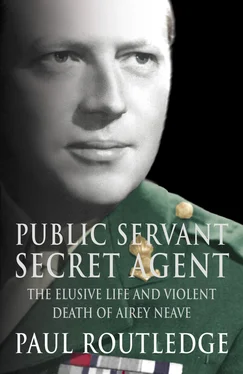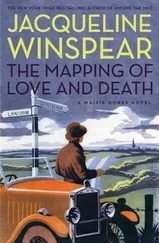However, the family’s upward mobility was undeniable. Sheffield Neave, another Governor of the Bank of England (1857–9), gave his Christian name to succeeding generations (some noted for their longevity), one of whom was Airey’s grandfather, Sheffield Henry Morier Neave (1853–1936), well-known in Essex for his eccentricity. He inherited a fortune while still at Eton, and went up to Balliol College, Oxford, where he acquired a degree but showed no inclination to pursue a profession thereafter. With plenty of money and no need to work, he indulged his passion for big game hunting, spending long periods in Africa, where he became convinced that control of the malarial tsetse fly was the only bar to great agricultural prosperity in sub-Saharan Africa. He returned to England and studied to become a doctor in middle age, eventually rising to become Physician of The Queen’s Hospital.
At the age of twenty-five, Sheffield Neave married Gertrude Charlotte, daughter of Julius Talbot Airey. They lived at Mill Green Park, Ingatestone, which was to become the family seat, and it was to Mill Green that Neave would return after his incarceration in Colditz. He dreamed vividly of the house during his captivity, and lyrically described its chestnut trees, its May blossom and the white entrance gates in his first book, They Have Their Exits.
Sheffield Neave had his own Essex stag hounds and was a legend in the field. Ever the eccentric, the stags he hunted were not wild but carted to the meet in the same vehicle as the hounds: ‘There was never any question of the hounds killing the stag, who was much too valuable to be lost in this way,’ Julius Neave has explained. 1 ‘They all came home to Mill Green at the end of the day and were stabled together.’ Sheffield gave up stag-hunting at the turn of the nineteenth century, complaining that ‘Essex is getting too built over’, but he rode to hounds until nearly eighty, when he took up golf instead. Long after his death a particularly vicious jump over a ditch and stream was still known as ‘Neave’s leap’.
Gertrude Neave, the epitome of a Victorian lady, was an accomplished pianist and also composed music. She came from a distinguished family, one of her relations being General Lord Airey, chief of staff to Lord Raglan, Commander-in-Chief of the British army in the Crimean War. He was, reputedly, the ‘someone who blundered’ over confused orders which led to the Charge of the Light Brigade. Gertrude and Sheffield had two sons and two daughters. The elder son, Sheffield Airey, born in 1879, was Airey Neave’s father; the younger, Richard, became a professional soldier and saw service in the Boer War, India and in Gallipoli in 1916. He also served in Ireland during the Troubles of 1920–22, and Airey may well have heard stories of ‘the Fenians’ from his uncle.
Airey’s father went to prep school in Churchstoke, in the Welsh Marches, and then (as befits the grandson of a Governor of the Bank of England) on to Eton and Magdalen College, Oxford, to read natural sciences. He inherited his father’s fascination with Africa and the diseases spread by insects. In the years before the Great War, he travelled in 1904–5 on the Naturalist Geodetic Survey of Northern Rhodesia, and to Katanga as entomologist to the Sleeping Sickness Commission of 1906–8. On his return from Africa, he served in a similar capacity on the Entomological Research Committee for four years before being appointed Assistant Director of the Imperial Institute of Entomology at the age of only thirty-four. He was to hold the post for thirty-three more years and then took over as director in 1942, the year Airey escaped from Colditz, before retiring in 1946.
A big, dominant man with a moustache, Sheffield Neave was a distant figure, immersed in his scientific work and given to a Victorian aloofness from his children. After Airey’s birth, the family moved to a house in High Street, Beaconsfield, Buckinghamshire, where four more children were born: Averil, Rosamund and Viola, and then a second son, Digby. Dorothy Neave, descended from an Anglo-Irish family, played a traditional role in the family: she ran a comfortable if unostentatious household. There were servants and appearances to keep up but Dorothy was often unwell and died of cancer in 1943 when Airey was working for MI9. Airey’s daughter Marigold says that he did not have a good relationship with his father. ‘He was very much a scientist. Perhaps that is what made him not very easy to get on with. He was very remote, a very Victorian figure.’ 2 If not physically robust, Airey’s mother possessed a mental determination unusual in her position. ‘Grandmother was quite forward-looking, quite progressive for those days. She was a liberal with a small “l”,’ recorded Marigold. ‘His childhood was not very easy. His mother was very often ill. Officially, he looks very much like her, but he never talked about her. He talked about his father, but not in very glowing terms. He was a very strict character, powerful and good-looking: a strong face, very dark eyes. And physically he was very tough. It was a clash of personalities.’ Group Captain Leonard Cheshire, the Dam Busters war hero, friend and contemporary at Merton, would come to a similar conclusion. Neave, he wrote, was highly independent and always ready to follow his inner convictions. ‘No matter what the opposition, he would often do things that were a little wild, though always in rather a nice way and never unkindly.’ This trait endeared him to school and university friends, ‘but possibly had a different effect upon his father who one has the impression did not always give him the encouragement which inwardly he needed. Thus, at a very early age he learned to conceal his inner disappointments.’ 3
Airey Neave attended the Montessori School in Beaconsfield, a progressive school where his individuality was respected. In 1925, at the age of nine, he was sent to St Ronan’s Preparatory School in Worthing, Sussex. The headmaster, Stanley Harris, was a remarkable man who had played football for England, and captained the Corinthians, the famous amateur team. The essence of his educational philosophy was captured in the school prayer, known as Harry’s Prayer, which ran:
If perchance this school may be A happier place because of me Stronger for the strength I bring Brighter for the songs I sing Purer for the path I tread Wiser for the light I shed Then I can leave without a sigh For in any event have I been I.
Set in several acres on the outskirts of Worthing, St Ronan’s placed great emphasis on academic excellence, sport and self-development. In many ways an archetypal English prep school – numbering future air vice-marshals and an Asquith among its pupils – it was built in red brick and sat against the backdrop of the South Downs. Despite the usual rigours of such places, the school had a patriotic rather than militaristic air about it. There was no cadet corps but boys were taught shooting, and from time to time a former army sergeant – so old that he had been with Kitchener at Khartoum – came to the school to teach gymnastics and boxing. With their days filled, in the evenings boys were allowed to pursue their own interests. In Neave’s time, some of them built a primitive radio – a crystal set with ‘cat’s whiskers’ tuning. Others drew maps of imaginary countries, bestowing such nations with complex railway timetables. Essentially, they had to learn to make their own amusement, and learn to fend for themselves, all of which helped develop a form of independence.
In 1926 Stanley Harris died of cancer and his place was taken by his brother, Walter Bruce (Dick) Harris, then a housemaster at nearby Lancing College. If Airey was a better than average pupil he was not spectacularly so, and seems to have been suited to his first form which was ‘composed mostly of boys with plenty of ability, one or two of whom however have no great idea of work’. In 1925, he won a combined subjects prize, but in class 1A in 1927 he was fourteenth. By the following year he had crept up to eleventh, then ninth and finally sixth, with 1, 205 points. That autumn, he also won the Latin prize. The highest placing he received was third, but mostly he fluctuated around the lower end of the top ten. The boys were expected to take a full part in the life of the school. Airey played a waiter in the school play in 1928, and the St Ronan’s magazine observed: ‘A word must be given to Neave who by progressive stages became the perfect waiter.’ Praise indeed.
Читать дальше












